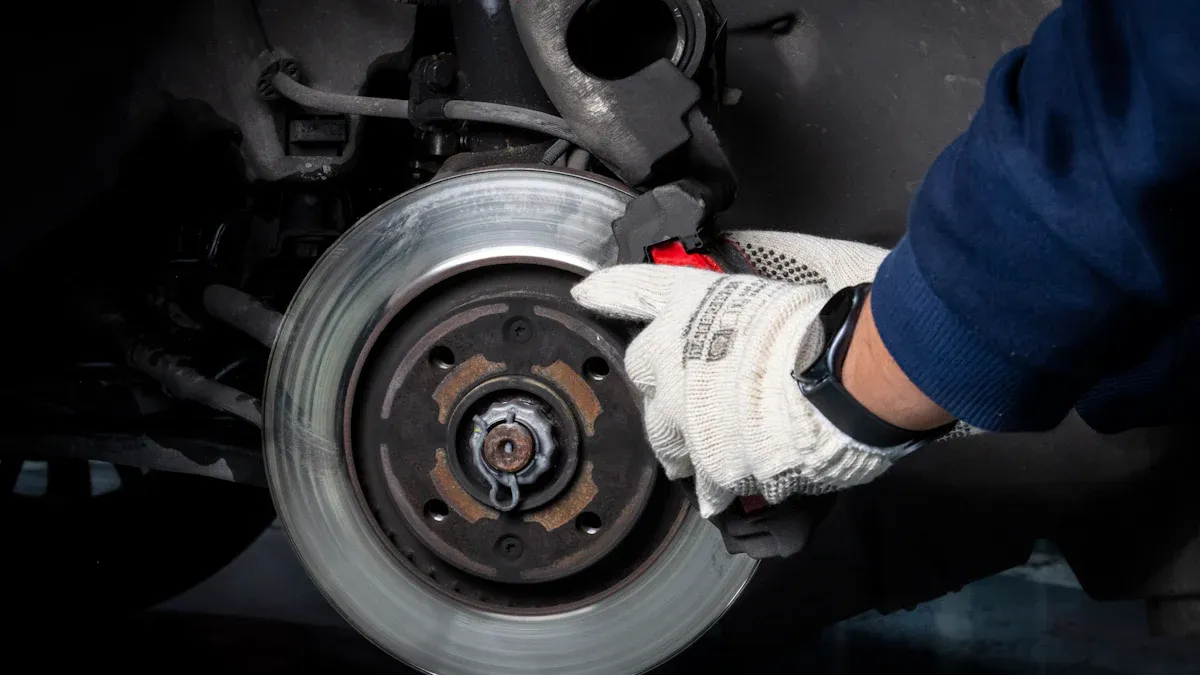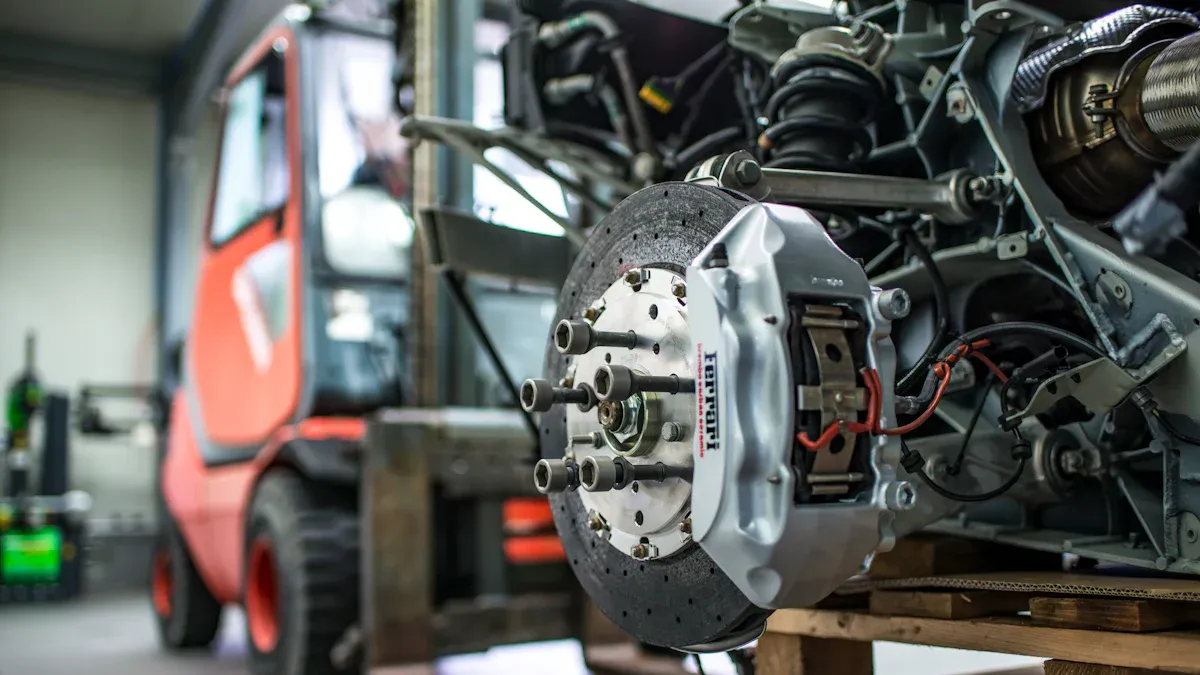
Not all trucks use automatic slack adjusters. Trucks built after October 20, 1994, generally include these due to federal regulations. However, older trucks often rely on manual slack adjusters. These require frequent adjustments to ensure proper brake function. Automatic slack adjusters improve safety by maintaining correct brake settings without manual intervention.
Key Takeaways
- Not every truck has automatic slack adjusters. Trucks made after October 20, 1994, are required to have them by law.
- Checking slack adjusters often is very important. It helps find problems early and keeps brakes working safely.
- Changing from manual to automatic slack adjusters can make older trucks safer and save time on repairs.
Understanding Slack Adjusters

What are slack adjusters?
Slack adjusters are essential components of a truck’s braking system. They connect the brake chamber to the brake camshaft. When you press the brake pedal, the slack adjuster helps transfer force from the brake chamber to the camshaft, which applies the brakes. Without this part, the braking system would not function properly.
You can think of slack adjusters as a lever. They amplify the force applied by the brake chamber, ensuring the brakes engage effectively. This makes them a critical part of maintaining safe and reliable braking performance.
The role of slack adjusters in truck braking systems
Slack adjusters play a vital role in keeping the brakes properly adjusted. Over time, brake components wear down, which can create a gap between the brake shoes and the drum. If this gap becomes too large, the brakes may not work as they should.
Slack adjusters automatically or manually adjust this gap to ensure the brakes remain responsive. By maintaining the correct clearance, they help prevent accidents caused by brake failure. For you as a truck operator, understanding how slack adjusters work can help you identify potential issues before they become serious problems.
Manual vs. automatic slack adjusters
There are two types of slack adjusters: manual and automatic. Manual slack adjusters require you to adjust them regularly using tools. This process ensures the brakes stay in proper working order. However, manual adjustments can be time-consuming and require frequent attention.
Automatic slack adjusters, on the other hand, adjust themselves as the brakes are used. They reduce the need for manual intervention, saving you time and effort. Most modern trucks come equipped with automatic slack adjusters because they improve safety and reliability. However, even automatic slack adjusters need regular inspections to ensure they are functioning correctly.
Tip: If you operate an older truck with manual slack adjusters, make it a habit to check and adjust them frequently. This will help you avoid brake-related issues on the road.
Regulations for Automatic Slack Adjusters
Federal requirements for automatic slack adjusters
Federal regulations mandate the use of automatic slack adjusters on most commercial trucks. These rules aim to improve road safety by ensuring that braking systems remain properly adjusted. Automatic slack adjusters reduce the risk of brake failure caused by human error or neglect.
The Federal Motor Carrier Safety Administration (FMCSA) enforces these requirements. You must ensure that your truck complies with these standards if it falls under federal jurisdiction. Non-compliance can lead to penalties, including fines and vehicle out-of-service orders.
Note: Automatic slack adjusters are not just a convenience. They are a legal requirement for many vehicles operating on public roads.
Implementation year and affected vehicles
The federal government introduced the requirement for automatic slack adjusters on October 20, 1994. Trucks, trailers, and buses manufactured after this date must include these devices. This regulation applies to vehicles with air brake systems, which are common in heavy-duty trucks.
If you operate a vehicle built before this date, it may still have manual slack adjusters. However, upgrading to automatic slack adjusters can improve safety and reduce maintenance time. Many fleet operators choose to retrofit older vehicles to meet modern safety standards.
Exceptions for older trucks
Not all trucks are required to have automatic slack adjusters. Vehicles manufactured before October 20, 1994, are exempt from this rule. If you drive an older truck, you may still use manual slack adjusters. However, you must inspect and adjust them regularly to ensure proper brake function.
While older trucks are exempt, you should consider the benefits of upgrading. Automatic slack adjusters provide consistent performance and reduce the risk of brake-related accidents. Retrofitting your truck can also help you avoid potential issues during roadside inspections.
Tip: Even if your truck is exempt, staying informed about modern braking technology can help you make better maintenance decisions.
Maintenance and Safety of Slack Adjusters

Importance of regular inspections
Regular inspections are crucial for keeping your truck’s braking system in top condition. Over time, slack adjusters can wear out or malfunction, which may lead to unsafe braking performance. By inspecting them frequently, you can catch potential problems early and avoid costly repairs or accidents.
You should check for signs of wear, such as loose connections or unusual noises when braking. Pay attention to the adjustment arm and ensure it moves freely without resistance. If you notice any issues, address them immediately to maintain your truck’s safety and reliability.
Common issues with automatic slack adjusters
Automatic slack adjusters are designed to reduce manual adjustments, but they are not immune to problems. One common issue is improper installation, which can prevent the adjuster from working correctly. Dirt and debris can also build up, causing the adjuster to stick or fail.
Another issue is wear and tear on the internal components. Over time, these parts may lose their ability to self-adjust, leading to a gap in the braking system. Regular maintenance helps you identify and resolve these problems before they affect your truck’s performance.
Tips for maintaining compliance and safety
To stay compliant with federal regulations, always ensure your slack adjusters are functioning properly. Keep a maintenance schedule and inspect your braking system regularly. Clean the adjusters to remove dirt and debris that could interfere with their operation.
If you operate an older truck with manual slack adjusters, make adjustments frequently to avoid brake failure. For automatic slack adjusters, follow the manufacturer’s guidelines for maintenance and replacement. Staying proactive helps you avoid penalties and ensures your truck remains safe on the road.
Most modern trucks come with automatic slack adjusters. These devices improve safety by keeping brakes properly adjusted without manual effort.
- Why it matters:
Understanding the difference between manual and automatic slack adjusters helps you make informed decisions about maintenance and upgrades.
Regular inspections and compliance with regulations ensure your truck’s braking system stays reliable and safe on the road.
FAQ
What happens if automatic slack adjusters fail?
If automatic slack adjusters fail, your brakes may not function properly. Inspect them regularly and replace faulty adjusters to maintain safe braking performance.
Can you replace manual slack adjusters with automatic ones?
Yes, you can upgrade manual slack adjusters to automatic ones. Consult a professional mechanic to ensure proper installation and compatibility with your truck’s braking system.
How often should you inspect slack adjusters?
Inspect slack adjusters during every pre-trip inspection. Look for wear, loose connections, or improper adjustments to ensure your brakes remain safe and compliant.
Tip: Regular maintenance prevents costly repairs and ensures your truck stays roadworthy.
Post time: Apr-17-2025

